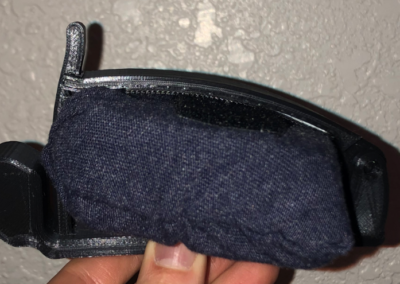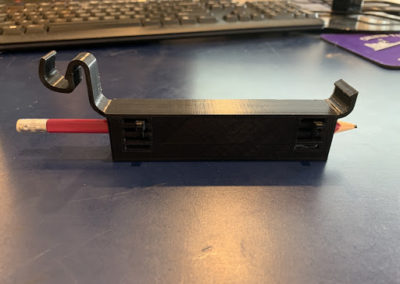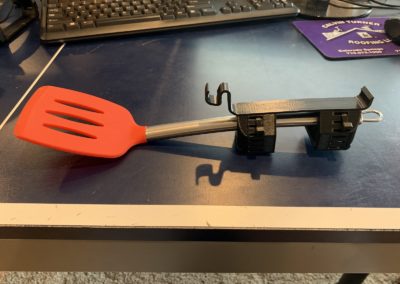Helping Hands
Overview
This project aims to create a low-cost, multi-function cuff aid for people with low cervical spinal injuries. These patients have a limited range of motion in their forearm and hands, and the multi-functional cuff aid is designed to increase the user’s independence and ability to complete activities of daily living, for example: brushing their teeth, eating dinner, using the computer, etc.
This project is being completed for Craig Hospital, a world-renowned rehabilitation hospital that exclusively specializes in the neuro-rehabilitation and research of patients with spinal cord and brain injuries.
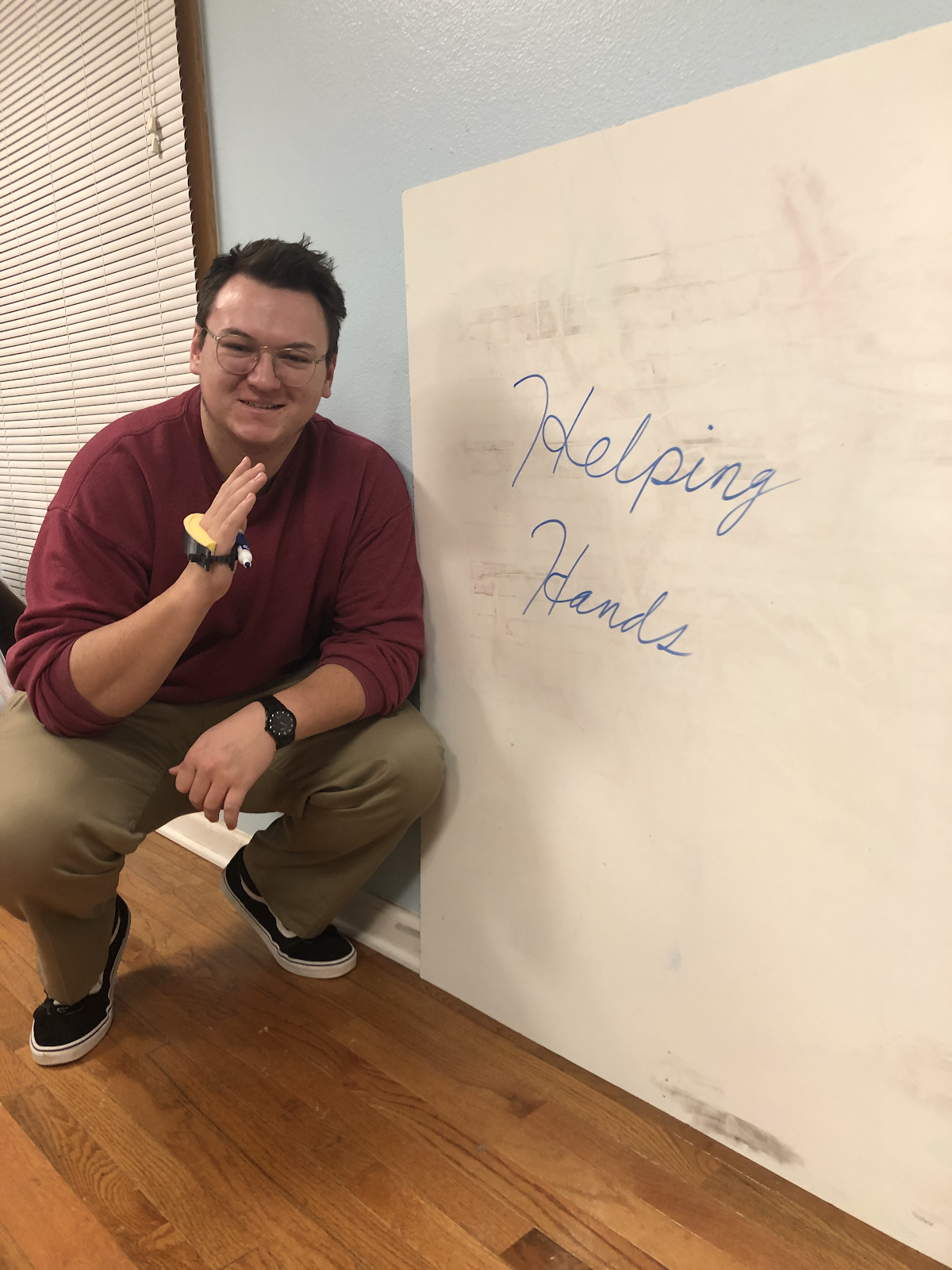
Elevator Pitch
This is a universal cuff in order to improve the lives of people who are affected by spinal cord injuries. Specifically, this device is for patients who have C5 to C7 injuries, and who lose a lot of the function in their hands and fingers. This device is extremely low cost, able to be 3-D printed at home, and allows the user to access a level of independence that the current technology does not allow for.
The device works by having the user press the top lever arm down into the ratchet system, which holds the cuff securely onto the hand. The user attaches their daily utensils to the clip portion of the design, and then is able to freely and easily swap between utensils at will.
Design Approach
After consulting with the client and various occupational therapists at Craig Hospital, the team determined that the project boundary of most importance is the user friendliness of the system. The users should be able to use the device with limited assistance. For this reason, the final design features a mechanism for adjusting the size of the cuff using a ratcheting lever system. This allows a user to close the cuff to a comfortable size. Furthermore, the proposed design will have a layer of padding or foam separating the hand from the plastic. This will help the cuff fit multiple sized hands as well as creating a more comfortable and secure fit for all day use if necessary.
The attachment mechanism for our design is adapted from a clip that remote control battery chambers use. This attachment was decided on because it performed the best in our attachment/detachment tests, and provides the user with the most stability. Another reason for the decision of this attachment is the auditory and tactile response to the user when connecting to the cuff. This allows the user to know when the object they need is securely attached.
Due to the quick production of prototypes, the models were constantly adjusted to remedy issues that were discovered in previous models. This process of quickly iterating through different designs allowed us to produce a product that fit the design goals established at the beginning of the project.


Design Solution
The original design goals for this project included universality, user friendliness, low cost, and durability. The team made these design considerations at high importance when creating prototypes and ultimately the final design. The Demand/Wish table below displays how the final design compares to what was originally asked by the client.
|
Demand/Wish |
Need Statement |
Pass/Fail |
|
Demand |
U cuff design must give a higher level of independence than current standard |
Pass |
|
Demand |
End user should be able to don and doff the U cuff independently |
Pass |
|
Demand |
Unit price for each U cuff should be between $2 – $100 |
Pass |
|
Wish |
Design should be open sourced and readily available to end users |
Pass |
|
Demand |
Design should allow for easy attachment of tools and utensils in order to give end users more independence |
Pass |
|
Wish |
U cuff should integrate onto a patient’s wheelchair joystick for convenient storage |
Fail |
The ultimate and most important demand of this project was to increase the user’s independence. The final design allows the user to don and doff independently without the help of an assistant. The various sized end effectors work with a wide range of objects and tools used in their everyday life. The attachment mechanism provides tactile and auditory response back to the user while securing the tools to the cuff. Also, this device is manufactured by 3D printing; the user will only pay for material costs and access to a 3D printer, keeping the overall cost of the device significantly low compared to what is on the market now. The only category not passed was integrating the cuff onto a patient’s wheelchair. This was a wish discussed at the beginning of the project, but later dismissed as other criteria were more important.
The durability of the device was tested through experimental drop tests and FEA analysis. The FEA showed areas of high stress concentration around the hinge and pivot point. The testing confirmed this by breaking at the hinge when a force of 115 N was placed on the hinge. With this information, the team adjusted the design and improved areas of concern.
The final design is shown below in Figure 2. The top left image illustrates the cuff in the open position. The user would place their hand into the opening, and then tighten the ratchet down to the appropriate tightness. The top right shows the Cuff and the End Effector prior to being connected together. The user would then place their hand (with the Cuff already attached) onto the attachment, which would then snap into place resulting in the configuration shown in the bottom image.
Next Steps
In the future, the cleanability of the design could be improved. Currently, there are a lot of nooks and crannies that dirt and debris could become stuck in. Also, the current material used, PLA, it is not dishwasher safe and must be hand washed. In the future, testing should be done to see if the material properties of nylon, which is dishwasher safe, have the same durability and 3D printing capabilities as the PLA.
Some other work that still needs to be completed is choosing the correct padding for the cuff. The padding for the universal cuff is pertinent to the design. The padding assures universal hand size capability while creating comfort and security to the cuff. The team has come up with 3 viable options for padding, each with their own pros and cons. 2 of the designs use an inexpensive multipurpose foam padding cut into a 3x 3×1.5 inch block. The positive aspects of the foam padding are the malleability and comfort it provides for the user. However, the main negative is that the material can degrade and wear quickly.
Padding Options
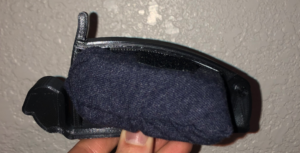
The first design tries to compensate for the wear of the foam. This design utilizes a sewn cover that allows for removal and cleanability cover instead of damaging the foam. The fabric of the cover can incorporate waterproof or resistant properties to help elongate the life of the foam. The downside of this design is that the user would need help to sew the cover together and secure velcro onto the fabric. This design expects too much of the user to be able to effectively create this themselves.
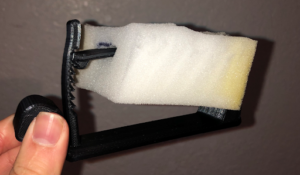
The second design for the foam is to eliminate the sewing aspect of the design. The user would need help cutting an inch wide slit, approximately half an inch from the top, through the entire length of the block. This allows the foam to slide right over the top of the cuff. This is more accessible and easier to manufacture for the users, however the foam is more vulnerable to degradation and wear. The foam would need to be replaced more often than the foam with the cover.
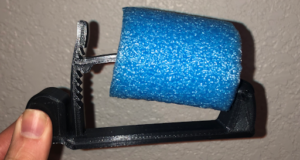
The last design for the padding is a cut pool noodle. By cutting the bottom edge of the pool noodle and making it flat, the pool noodle fits correctly and is secured on the user’s hand. Also, the pool noodle is waterproof and easily cleaned. The downside to this design is that the pool noodle is more rigid and generates more tension on the top of the cuff and the hinge. This might cause the cuff to open unexpectedly because of this tension.
Meet the Team
Cameron Stoesser

Cameron Stoesser is a Mechanical Engineer at Mines. He took charge of creating the prototypes using a 3D printer, as well as creating CAD models for the prototypes. He enjoys video games, watching sports, and the outdoors.
Nicole Latourette
 Nicole Latourette is a Mechanical Engineer at Mines. la. She served as a team leader and also helped model different project ideas in Solidworks. She played on the soccer team at Mines and enjoys art, the outdoors, and shopping.
Nicole Latourette is a Mechanical Engineer at Mines. la. She served as a team leader and also helped model different project ideas in Solidworks. She played on the soccer team at Mines and enjoys art, the outdoors, and shopping.
Ryneika Knight
 Ryneika Knight is a Mechanical Engineer at Mines. She helped brainstorm ideas for different prototypes, and also helped draft CAD models for those ideas. She enjoys video making, spending time with her friends, and playing with her dog.
Ryneika Knight is a Mechanical Engineer at Mines. She helped brainstorm ideas for different prototypes, and also helped draft CAD models for those ideas. She enjoys video making, spending time with her friends, and playing with her dog.
Kyle Hatch
 Kyle Hatch is an Electrical Engineer at Mines. He helped brainstorm ideas for different prototypes, led product testing, and he served as the webmaster for the project. He enjoys playing music and video games.
Kyle Hatch is an Electrical Engineer at Mines. He helped brainstorm ideas for different prototypes, led product testing, and he served as the webmaster for the project. He enjoys playing music and video games.
